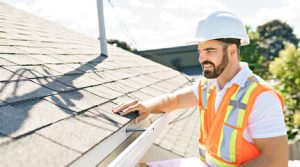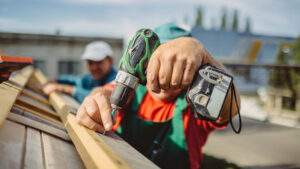Your roof is an unsung hero, protecting your home from the elements. But just like any other structural component, your roof requires routine inspections.
Routine roof inspections help catch small issues like loose shingles or minor cracks before they become major problems. This proactive approach extends your roof’s lifespan, saves on repair costs, and preserves its value and resale potential. Read on and Find Out More Here.

Frame Straightening
The roof is your home’s first line of defense against the elements. It shields your family and possessions from rain, snow, hail, high winds, and sunlight. Unfortunately, it is often overlooked until a problem arises. That is why regular roof inspections are so important to safeguard your investment and prevent costly damage.
A certified inspector examines the exterior of your roof, checking for missing or damaged shingles and structural integrity. They check for water penetration through deteriorating sealants, as well as other signs of a leaky roof, including stains on the ceiling or walls, mold growth, and sagging. An inspection also reveals issues such as improper ventilation, which can cause moisture buildup and lead to the need for a roof replacement. An inspector also checks the condition of gutters and downspouts, evaluating clogs and rust. They also inspect the insulation and ventilation systems in the attic.
Storms can wreak havoc on your roof, even if the damage isn’t visible. High winds can loosen shingles, hail can create dents or cracks in the structure, and heavy rains can expose weak points. Scheduling a post-storm inspection ensures that any damage is identified and repaired promptly before it can worsen.
An inspected roof is more energy-efficient, too. Missing shingles and insufficient insulation cause air leaks, leading to higher heating and cooling costs. A professional can identify and correct these problems to save you money on your utility bills and help you reduce carbon emissions.
Performing regular maintenance protects your investment and extends the lifespan of your roof. It also helps avoid costly repairs, maintains a safe environment for your loved ones, and adds value to your property. A well-maintained roof protects against structural damage, water intrusion, and deterioration of interior furnishings. It also prevents heat loss in winter and excessive heat absorption in summer, lowering energy costs.
If you have noticed uneven tire wear, a pulling sensation while driving, or other signs of misalignment, you may need frame straightening services. A skilled technician can restore your car’s structural integrity using a variety of methods, including frame pulling, section replacement, and panel bonding.
Auto Body Repair
The roof is the first line of defense against harsh environmental conditions. It shields a building and its occupants from heat, sun, wind, rain, and snow. Unfortunately, many property owners neglect roof maintenance. This can lead to structural damage and costly repairs. Fortunately, preventive maintenance and regular roof inspections can extend the lifespan of a commercial or residential roof and protect it from severe weather and water damage.
During routine roof inspections, professionals check the condition of gutters and downspouts, the insulation in the attic, and the presence of any signs of leaks or mold. They also look for damaged shingles, flashing, and structural weakness. Identifying these issues early prevents them from escalating into expensive structural problems, which can lead to foundation damage and structural weakening.
Leaks are often caused by missing or damaged shingles, and they can cause widespread interior damage if left unchecked. Water infiltration also promotes the growth of mold and mildew, which can compromise indoor air quality and pose health risks for occupants. Detecting and repairing leaks during inspections keeps these fungi at bay, while preventing water damage to drywall, insulation, electrical wiring, and other structures.
In addition to reducing structural damage and energy inefficiency, regular roof inspections can help save money on utility bills. Poorly maintained roofs with gaps and leaks can cause cold air to escape during the winter and hot air to leak out in summer, resulting in higher heating and cooling costs. Regular inspections ensure that a roof is properly ventilated and insulated, allowing it to regulate internal temperatures and reduce energy consumption.
In addition to protecting against structural damage and expensive repairs, a well-maintained roof improves the appearance of a building. This increases the curb appeal of a home or business and enhances its resale value in the event of a sale. It can also contribute to a more environmentally friendly living environment by reducing carbon emissions from heating and cooling a structure. Investing in roof maintenance and regular inspections will provide homeowners with peace of mind and reduce stress and expenses down the road.
Structural Diagnostics
The roof is one of your home’s most important structures. It shields you and your family from the elements, but it requires vigilance to remain in good condition. Neglecting your roof can lead to expensive repairs and compromise the structural integrity of your home. Regular inspections and preventive maintenance can save you money in the long run.
The frequency of your roof’s inspections should depend on a number of factors. For example, older roofs may require more frequent inspections to monitor the wear and tear of shingles or other roofing materials. Your geographic location may also determine how often you should schedule inspections because severe weather conditions can cause damage to your roof.
During a roof inspection, a qualified professional will check for the following:
Leaks
Water leaks can cause extensive damage to your home and property. From ruined furniture and carpets to rotted wood support beams, this damage is costly to repair. Furthermore, the moisture from a leaky roof can create the ideal environment for mold growth and other health issues.
In addition to repairing leaks, inspectors can perform other maintenance tasks to extend the lifespan of your roof and improve your home’s energy efficiency. For example, installing reflective roof coatings can protect against UV radiation and lower your home’s cooling costs. Additionally, regularly clearing gutters and downspouts prevents clogging, which can lead to water accumulation and damage. Regular trimming of tree limbs can also reduce the risk of damage from falling debris during storms.
Emergency fees can add up quickly, especially if you need to pay for unexpected repairs on short notice. However, if you catch problems before they worsen, you can plan and schedule repairs at a convenient time.
Many insurance policies and roofing warranties require regular maintenance to be valid, so maintaining your roof will help you avoid costly repair bills in the future. In addition, routine maintenance can also increase your home’s resale value. Lastly, a well-maintained roof contributes to improved indoor air quality and can cut down on your energy expenses by keeping heat inside during the winter and cool air during the summer.
Collision Repair
Your roof stands as your home’s unsung hero, shielding it from the relentless forces of nature. However, even the mightiest structures need vigilance and care to maintain their integrity. Neglecting your roof can lead to costly repairs and compromised safety for you and your family. Regular inspections can help prevent damage and extend your roof’s lifespan.
One of the most significant benefits of regular roof inspections is identifying minor issues before they escalate into major problems. For example, minor wear and tear, such as leaking shingles, cracks, and deteriorating flashing, can be addressed with minimal cost when caught early on during an inspection.
By regularly identifying and addressing these issues, you can save on energy bills throughout the year while protecting your investment from extensive water damage. It’s also important to note that many homeowners’ insurance policies and roofing warranties require routine maintenance to remain valid. Failure to follow these guidelines may result in a loss of coverage when an issue arises.
The frequency of roof inspections depends on a number of factors, including the age of your roof, the type of roofing material, and your geographic location. Generally, it’s recommended that your roof be inspected at least once every six months to detect potential issues and prevent expensive damage.
Aside from identifying minor issues, roof inspections can also spot safety hazards that need to be addressed immediately. For example, sagging shingles or weak support beams can compromise the structural integrity of your roof and present serious risks to your family. Regular inspections, both from the ground and up close using ladders when safe to do so, can help prevent these potential safety concerns and ensure that your roof is functioning as safely as possible.
While many homeowners wait until a problem arises before scheduling an inspection, doing so can be costly. Emergency repairs are typically more expensive than scheduled maintenance and often come with additional fees for after-hours work and inclement weather. Identifying and addressing small issues during regular inspections can save you money in the long run while preventing costly repairs and ensuring the safety of your loved ones.


